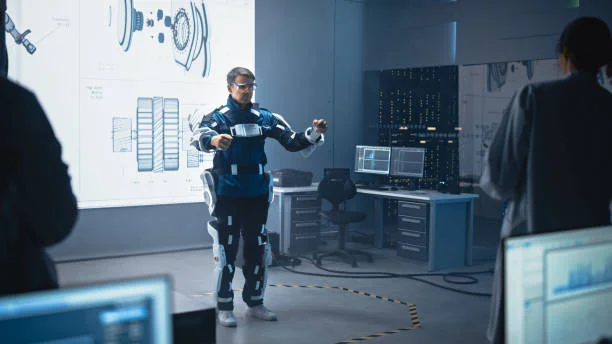Explosive Ordnance Disposal (EOD) units are among the most critical components of modern military and security operations. Tasked with neutralizing improvised explosive devices (IEDs), mines, and other hazardous threats, EOD technicians often work under extreme pressure in hostile environments. These missions demand not only exceptional technical expertise but also unparalleled precision and decision-making ability.
To meet these demands, cutting-edge training tools are required, and Virtual Reality (VR)-based EOD simulators have emerged as a powerful solution within the broader domain of VR military training. These simulators allow personnel to train in realistic, high-risk environments without putting lives at risk, improving both precision and safety in actual missions.
There’s so much more to discover—browse our related posts!
Challenges Faced in Traditional EOD Training
Traditional EOD training relies heavily on live demonstrations, controlled detonations, and limited mock scenarios. While effective in building foundational skills, this method suffers from several limitations:
- High costs of explosives, protective gear, and physical replicas
- Limited exposure to a wide variety of IED designs and deployment environments
- Restricted practice time due to safety regulations
- Psychological pressure that can’t be fully replicated in a classroom
These challenges underscore the need for a more scalable, adaptable, and immersive training solution that prepares EOD technicians for unpredictable field conditions.
What Are VR-Based EOD Simulators?
VR-based EOD simulators are immersive, interactive training systems that replicate real-world bomb disposal missions in virtual environments. Using VR headsets, motion-tracking controllers, haptic feedback devices, and software-powered scenarios, trainees are placed in lifelike situations that closely mimic combat or urban warfare zones.
These simulators cover various EOD tasks, including:
- Remote manipulation of explosive devices
- Robotic disarming operations
- Use of bomb suits and EOD tools
- Environmental navigation under pressure
VR-based platforms simulate complex threats without physical risks, making them an ideal supplement or even a potential replacement for live training in the early and intermediate stages.
Core Features of VR EOD Simulation Platforms
Effective VR EOD simulators are equipped with a suite of features that replicate real-life conditions and tools. Common capabilities include:
- Hyper-realistic 3D environments: Simulate urban streets, vehicles, desert terrains, and indoor scenarios
- Tactile interaction: Using VR gloves or haptics to mimic the handling of EOD tools
- Voice command integration: Emulates battlefield communication
- AI-powered threat behavior: Simulates enemy combatants, time-sensitive devices, or chain-reaction IEDs
- Custom scenario builder: Allows instructors to create mission-specific simulations
- After-action review (AAR): Provides feedback on precision, response time, and technique
These tools not only engage trainees visually but also help improve motor coordination, strategic thinking, and team communication.
How VR Enhances Precision in Bomb Disposal?
Precision in EOD operations is non-negotiable. One mistake can result in mission failure or loss of life. VR simulations help enhance accuracy in several ways:
- Repetitive skill drills: Trainees can repeat tasks like wire cutting, probe placement, and robotic control until perfect execution is achieved.
- Dynamic threats: Simulations include evolving devices with randomized mechanisms, forcing the user to stay alert and adapt under pressure.
- Fine motor practice: Simulated handling of tools—like deactivators or bomb suit functions improves muscle memory and hand-eye coordination.
- Instant feedback loops: Real-time performance data allows for rapid correction and improvement.
As a result, technicians gain better spatial awareness, tool familiarity, and procedural consistency, even before they handle a live device.
Improving Safety Through Realistic Hazard Scenarios
One of the most transformative benefits of VR-based EOD simulators is the ability to train for extreme danger safely. VR allows trainees to experience:
- Blast radius effects
- Secondary device detonation
- Environmental distractions like gunfire, civilians, or vehicle noise
- Chemical or biological threats
All of this occurs without physical risk, creating a safer learning environment while still maintaining psychological realism. Additionally, trainees can fail without consequences, which enables learning through trial and error something not possible in live training with real ordnance.
Integration with Real-World Robotics
Advanced VR EOD simulators don’t operate in isolation, they often integrate with real-world robotic systems and EOD tools. This hybrid approach blends the best of both worlds:
- VR-linked EOD robots: Trainees learn to operate real bots via virtual remote controls
- Sensor-based equipment simulation: Includes X-ray devices, chemical sniffers, and jammers
- Bomb suit calibration: Simulators mimic the restricted movement and heat of actual suits, helping users adjust to real-world physical limitations
Such integrations bridge the gap between digital training and field operations, ensuring that skills learned in VR can be directly transferred to actual equipment.
Benefits of Immersive EOD Training
By adopting VR EOD simulators, military and security forces gain multiple advantages:
- Accelerated learning curve: New recruits can complete complex simulations faster than traditional timelines
- Cost efficiency: Reduces expenditure on physical materials, travel, and setup
- Standardization: Ensures consistent training regardless of region or instructor
- Skill retention: High engagement and repetition lead to better long-term memory of procedures
- Operational scalability: Large teams can be trained simultaneously, even remotely
All of these contribute to better mission preparedness, fewer field errors, and improved soldier survivability in real high-risk scenarios.
Real-World Implementation of VR EOD Training
Several defense organizations have already begun implementing VR-based EOD training programs:
- U.S. Department of Defense: The U.S. Army Explosive Ordnance Disposal School at Fort Lee has incorporated immersive VR training modules to train soldiers on device disposal techniques.
- British Army: Partnered with simulation tech firms to develop VR-based route clearance and mine detection scenarios.
- NATO forces: Have adopted multinational VR-based EOD exercises that allow interagency coordination and skill benchmarking across countries.
These programs have reported reduced training incidents, increased simulation completion rates, and higher pass percentages in final assessments.
Limitations of VR-Based EOD Simulators
While VR-based EOD simulators provide significant value, they’re not without limitations:
- Initial investment: High-quality VR setups and software can be costly to implement.
- Technical challenges: Requires reliable power, updates, and tech support in training centers.
- Lack of physical stress simulation: VR can’t fully replicate the heat, weight, and fatigue of real EOD suits or battlefield conditions.
- Simulator sickness: Some trainees may experience motion sickness or discomfort during extended sessions.
To mitigate these issues, a blended training approach combining VR with hands-on modules is often recommended.
Conclusion
VR-based EOD simulators represent a revolutionary step in preparing personnel for one of the most dangerous tasks in modern defense. By enhancing precision, simulating high-risk environments safely, and providing scalable training options, these tools help bridge the gap between theoretical knowledge and practical expertise.
As explosive threats evolve in complexity and deployment, so must our training methods. Virtual reality offers a pathway to not just safer training, but to smarter, more capable, and more resilient EOD teams, ultimately saving lives and strengthening mission success rates. Partnering with a trusted VR solutions company can ensure your defense or security organization has access to the latest in immersive simulation technology, tailored to mission-critical needs.
Having more content? Dive into our latest posts now!






